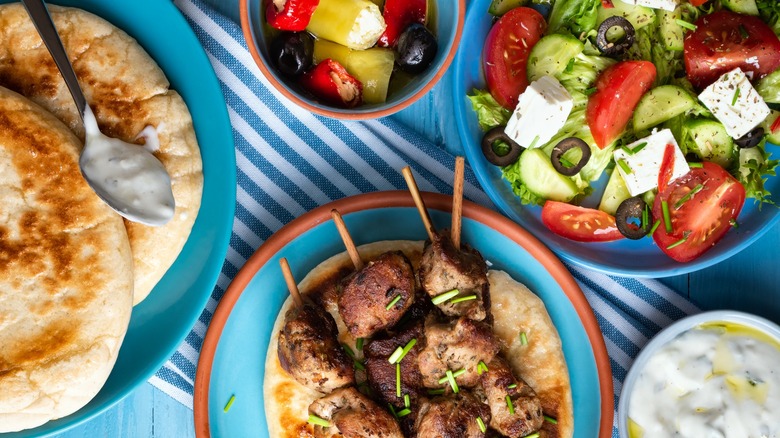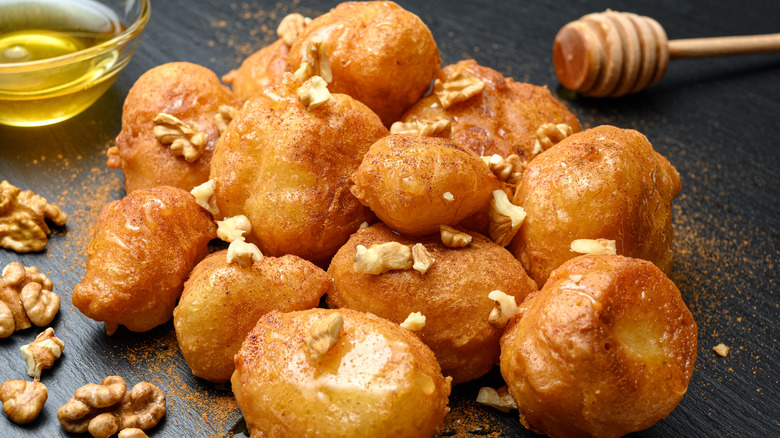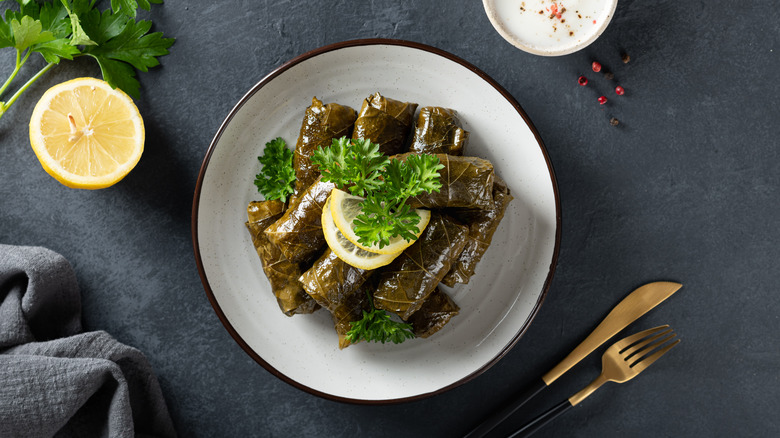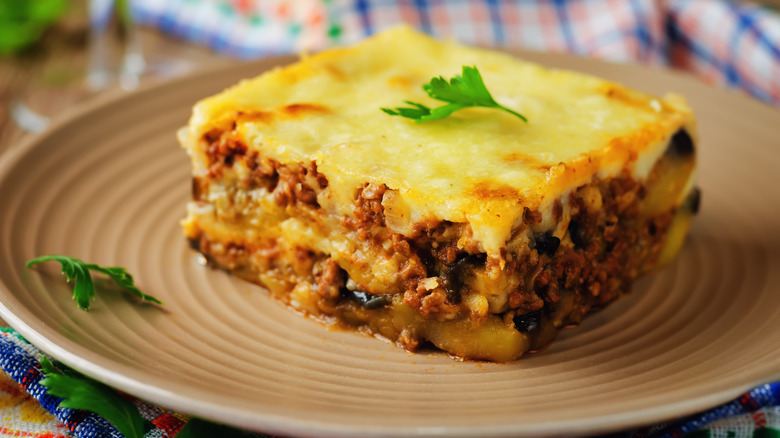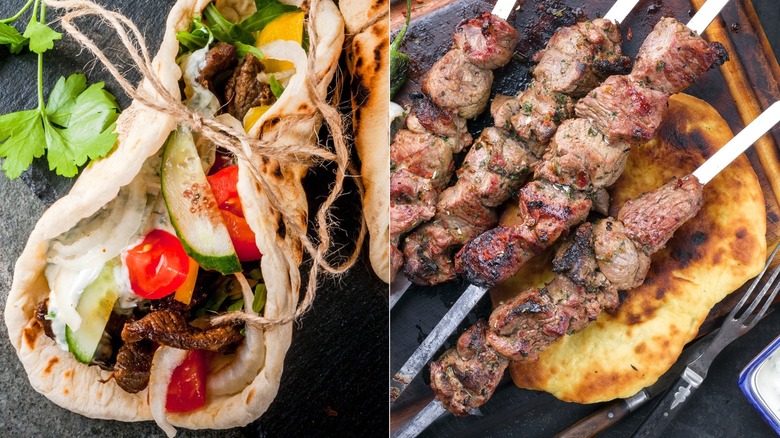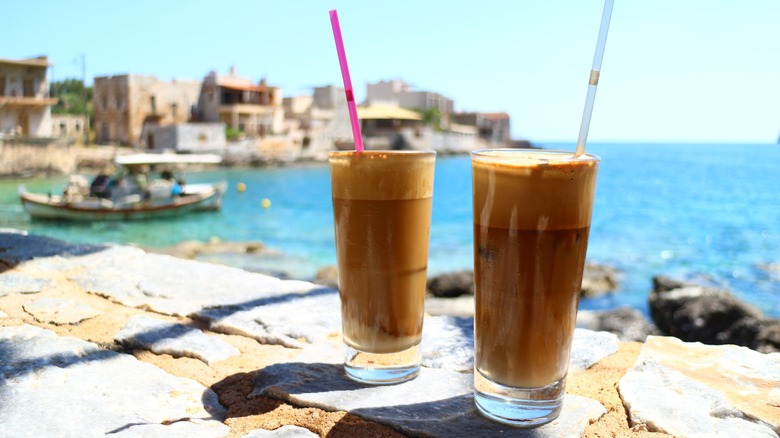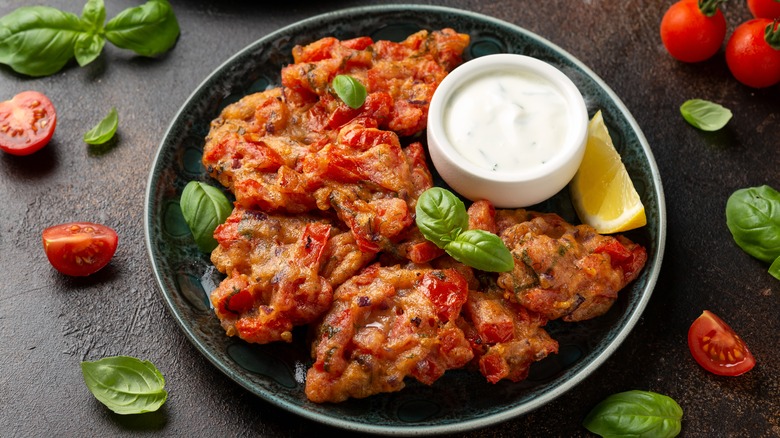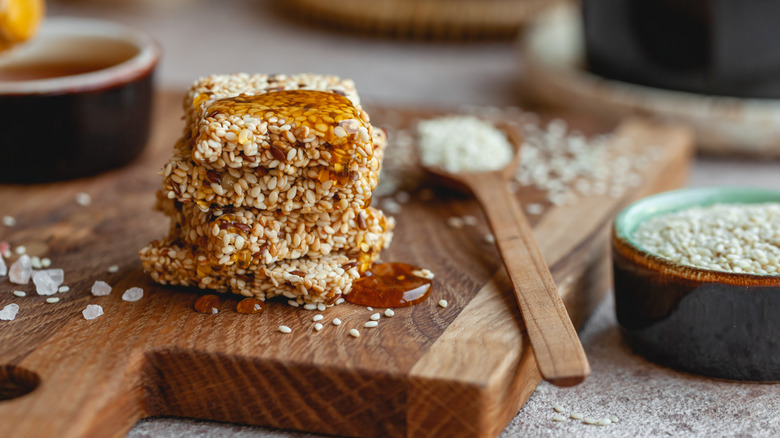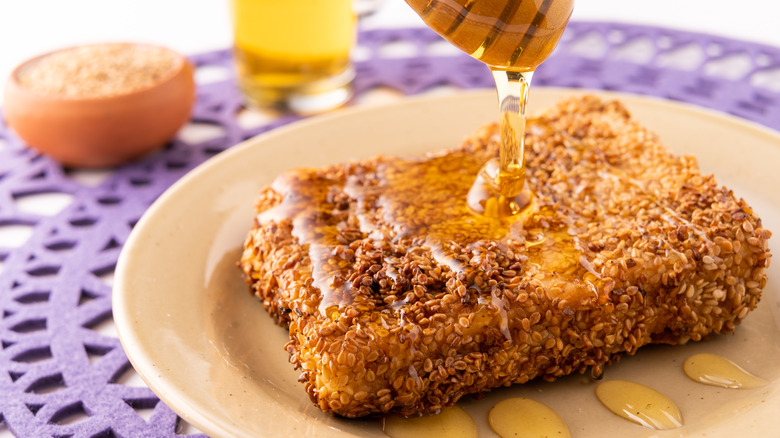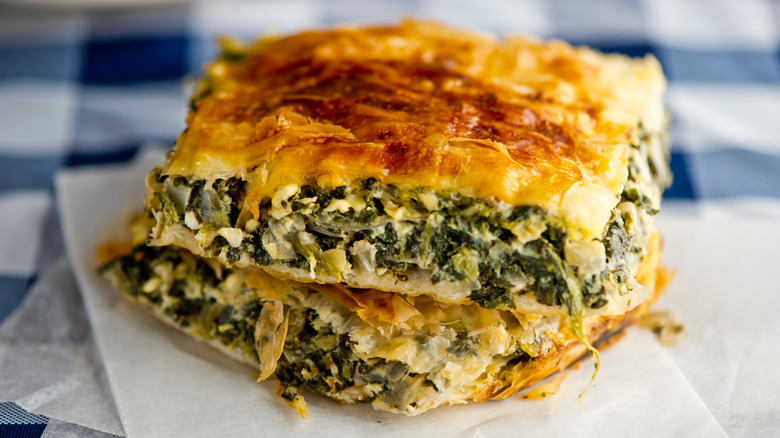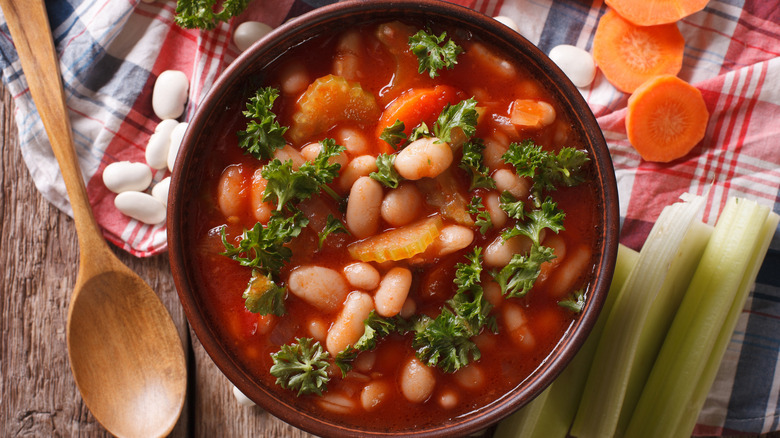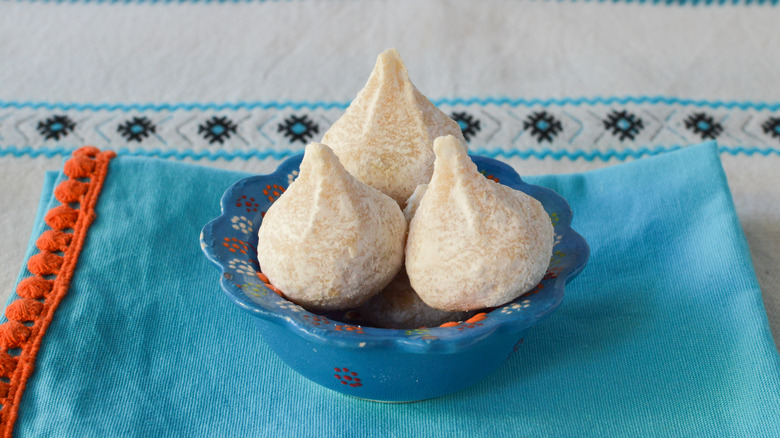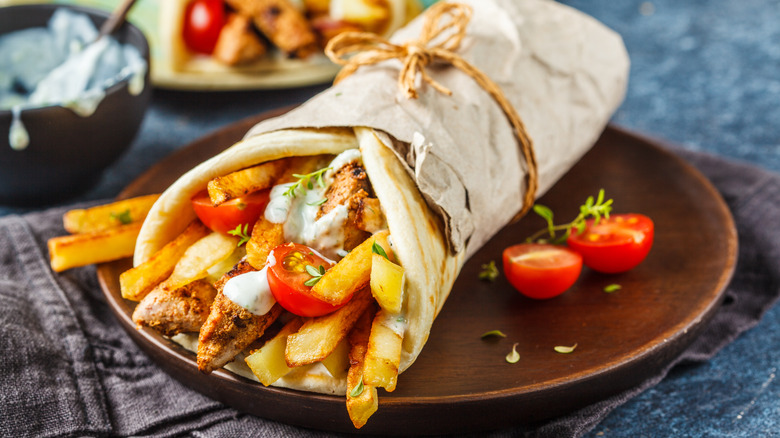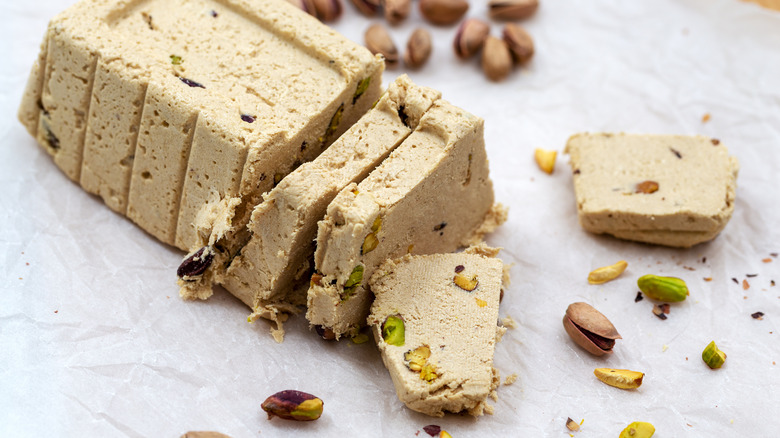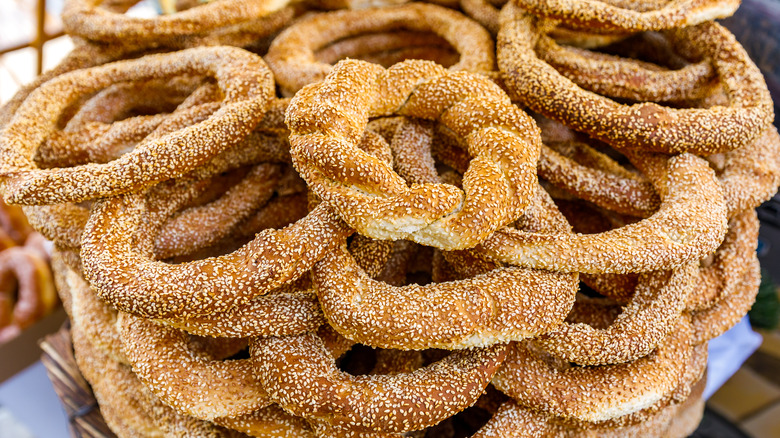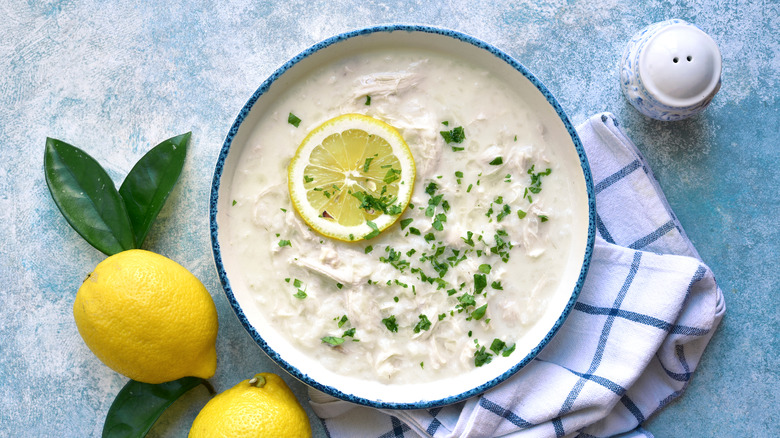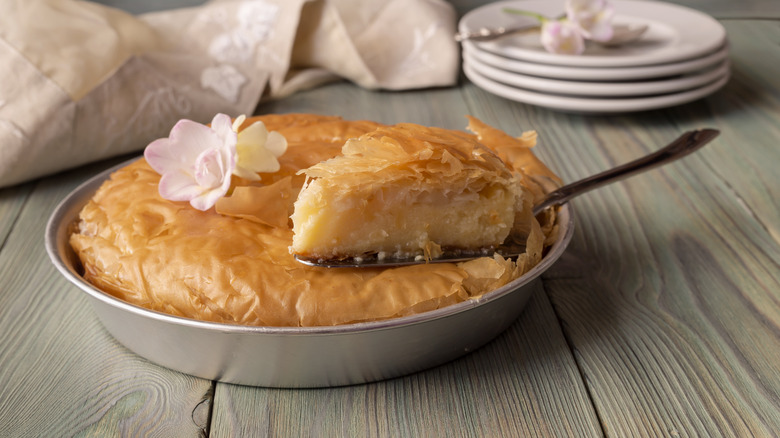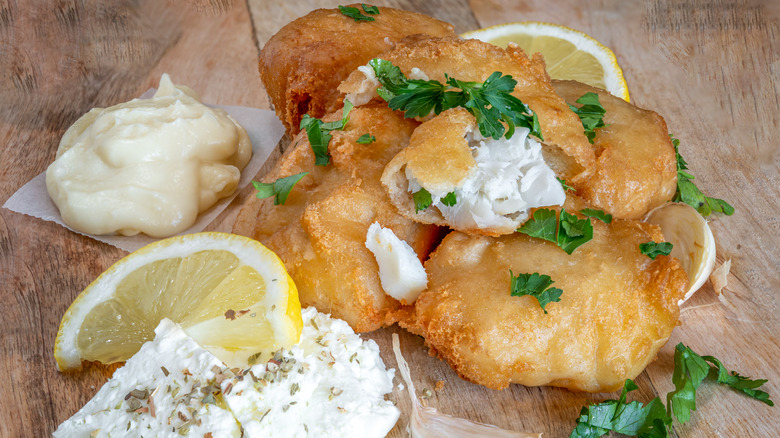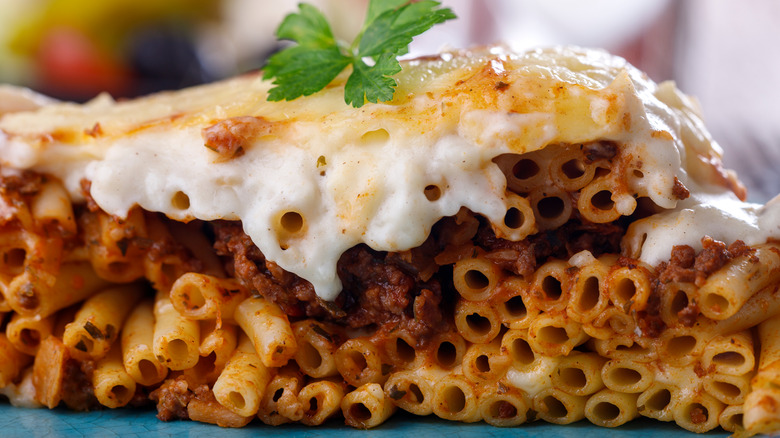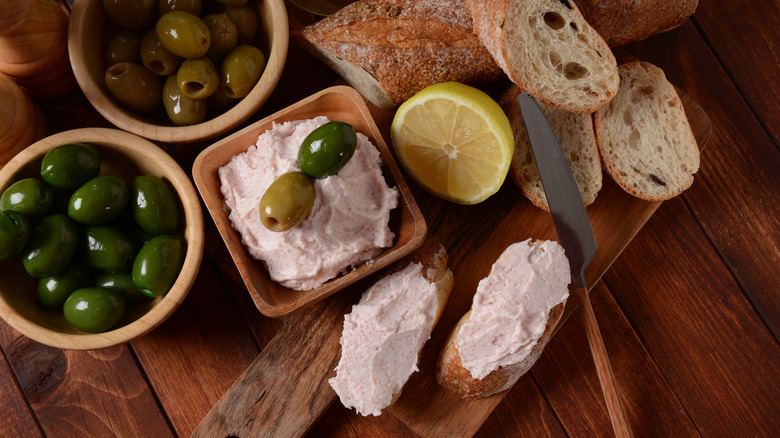20 Greek Dishes You Need To Try At Least Once
The history of Greece and its people is rich and glorious. Besides giving the world the concept of democracy that it enjoys today, as well as the Olympic games, the Greek civilization ranks amongst the world's oldest and groundbreaking civilizations, as noted by Discover. Without a doubt, a civilization this ancient and illustrious is going to have a culinary tradition that is just as old and rich as its history.
For centuries now, wine and bread have been central to Greek cuisine. Because of the Mediterranean climate of Greece, lemons and olives — including olive oil — are grown in abundance and used in the country's cooking. According to The Spruce Eats, the geographical makeup of Greece is such that 20%of the country is made up of small islands that are surrounded by sea and so, seafood is another mainstay of its cuisine. Greece also heavily grows and produces its own cheese, vegetables, nuts, fruits, grains, and legumes, all of which influence Greek food. Plus, various invasions in Greece's history have influenced its foods, particularly the rule of the Romans and the Ottoman Empire. This is why various Greek dishes are often found in Turkish cuisine as well, such as the pastry baklava, or have Turkish names, for example, tzatziki.
Indeed, Greek cuisine is undeniably vast and diverse, in which climatic, geographical, historical, and cultural factors all play a role. This being said, if you had to narrow Greece's cuisine down to 20, these are the 20 Greek dishes that you should try at least once.
Loukoumades
Donuts are a dessert universally loved across the world, albeit in different forms — as the beignet in France, bombolone in Italy, and churro in Mexico. Greece's loukoumades, however, are considered to be the first donut in the world and in Greece, the first recorded desert, according to Culture Trip. The Greek poet Callimachus mentions a version of loukoumades called charisoi, meaning charisma, which can be dated back to ancient Greece. These bite-sized donuts used to be presented to winners of the Olympic games as "honey tokens," as noted by the poet (in "The Vigil"), making loukoumades the first dessert to be mentioned in the world's literature.
Today, Olympic winner or not, loukoumades continue to be a favored street-side snack by everybody in Greece. The deep-fried golden puffy dough balls are usually eaten the traditional way — warm, with a generous drizzle of honey, and a sprinkle of cinnamon, per World Food Story. More modern versions can come with chopped nuts or sesame seeds, and often swap jam and liquid chocolate for honey. The odd savory versions with cheese and yogurt can also be found.
Dolma
Dolma refers to a type of appetizer wherein grape leaves are stuffed with various fillings, variations of which are found across several Balkan, Middle Eastern, and Mediterranean countries, per MasterClass. The Greek version goes by the name of dolmades or dolmadakia. According to legend, dolmades played an important role during the Enlightenment in Greece (via Ammon Express). Adamantios Korais, who was an important figure of the Greek Enlightenment, used to smuggle pieces of papers with writings from European thinkers to enslaved Greeks in an effort to encourage them. This contraband used to be hidden inside dolmades and as a result, the stuffed grape leaves were briefly declared illegal in all of Greece till the country's liberation.
The grape leaves can be stuffed with all sorts of fillings, including rice, onions, and tomato paste as well as herbs and spices in seasoning, according to WiseGeek. In general, two kinds of dolma exist — ones with a meat and rice filling and those without. Dolma without any meat often goes by yalanci, meaning "fake" due to the lack of meat. The filling is cooked partially and is added onto a grape leaf which is then rolled into a cigar-like shape. Pieces of dolma are lined onto a pan, water or oil is poured over them and the dolma is allowed to simmer till the filling is cooked. Although they can be eaten warm, dolma is usually eaten cold as a meze (an appetizer).
Moussaka
If you were to think of Greek food, moussaka would probably be the first item to come to mind. The baked dish, however, has quite the history. Many Balkan and Mediterranean countries have their versions of moussaka with wildly different ingredients but according to Cooks Without Borders, the Greek moussaka is a sort of casserole made with layers of eggplant and potato, soaked in a sauce of lamb and tomato, and is baked in an oven. The Greek moussaka has one more peculiar ingredient: the French béchamel sauce.
Considering the fact that Greek cuisine is heavily influenced by its invaders, the first sign of moussaka, too, is said to have appeared when the Arabs brought eggplants to Greece, as explained by Culture Trip. Years later, in an effort to rid the Greek cuisine of all its Turkish influence from the rule of the Ottoman Empire, Nikolaos Tselementes re-invented several Greek recipes, including moussaka, in an attempt to Europeanize and modernize them.
Interestingly, Tselementes, to whom much of the modern Greek cuisine is credited (via My Greek Odyssey), though born in Greece, was educated in France. This perhaps explains his addition of a French béchamel sauce to the Greek moussaka in 1920. Since then, although fillings occasionally vary, Tselementes' modern recipe for moussaka seems to have stuck.
Galaktoboureko
Galaktoboureko gets its name from gala, the Greek word for milk, and bourek, Turkish for pastry, according to WiseGeek. Simply put, galaktoboureko is a Greek dessert made from layers of milky custard sandwiched between sheets of flaky phyllo pastry. While people outside Greece may not be too familiar with the dessert, galaktoboureko is much loved by the Greeks for its light and not too sweet taste, which makes eating a handful of galaktoboureko in one go incredibly easy.
To make galaktoboureko, a custard mixture of eggs, semolina, butter, vanilla, milk, and sugar is cooked on the stove — only long enough until it thickens. The custard is then spread onto thin phyllo sheets and layered in a similar way to baklava or rolled into cigars and left to bake in an oven. The result is a filling of soft custard inside a crispy pastry that is soaked in a citrus syrup. While galaktoboureko is best enjoyed as a warm breakfast pastry with a cup of coffee, it can also be eaten cold after the custard has set some more, per Taste of Home. Or, if you're baking a big batch of galaktoboureko at home, the dessert can easily be reheated in the oven till the custard becomes a tad runny again.
Souvlaki
It is nearly impossible to imagine Greek food without souvlaki and rightly so, for the origin of the meaty dish goes back to centuries ago. According to Athens Insiders, the mention of souvlaki first appeared in Homer's epic Greek poem "Iliad," which described the war hero Achilles cooking meat over hot embers. At the time, souvlaki went by the name of obelisk and got its name from the Greek word for spit — obelos — referring to the method of cooking souvlaki meat over a spit. As for the term "kalamaki," it is merely another way to order souvlaki, depending on the region you're in, and ensures that the bread is on the side (versus the pita version, per TheTravelPorter).
Souvlaki, today, is a popular fast-food eaten as a street-side snack, either inside a pita or alongside a slice of bread or a baked pie sliced into four pieces. The skewered meat is usually made of roasted pork, though chicken, sausage, lamb, and beef are common, too. Traditionally, the meat skewers come with a side of tomatoes, onions, and the famous tzatziki sauce; however, parts of Northern Greece are known to serve ketchup and mustard as well, much to the rest of the country's chagrin. In the neighboring country of Cyprus, souvlaki is often served in a pita bread and the meat is sometimes replaced by the island country's famous halloumi cheese.
Frappe
Since Starbucks trademarked the use of Frappuccino for its iconic ice-blended beverages, the coffee chain's competitors and local cafes around the world have resorted to calling their versions of the blended drink a "frappe," per The Law of the Land. The real frappe, however, is nothing like the churned icy slush that we know it to be.
As reported by Vice, a "frappe" is a cold coffee drink invented in 1957 by Dimitrios Vakondios in Greece. The salesman was representing Nescafe at the World Fair exhibition in Thessaloniki when Vakondios accidentally made a concoction that is Greek's famous frappe today. As the story goes, Vakondios couldn't find any hot water to make his coffee but in desperate need of a caffeine fix, added Nescafe and sugar to a Nesquik shaker and shook it into a new, impromptu coffee-based drink. Since then, the frappe has become a beverage that is immensely popular in Greece and an important part of the country's social culture.
Frappes are taken so seriously in Greece that a drink not prepared properly is quickly dismissed. Per Vice, if the drink is too watery, it's waved off as nerozoumi or "water-brew." If the frappe is too sweet, it's labeled petimezi or "grape molasses." And so on. While the use of instant coffee powder may make frappe seem like a coffee that is low in caffeine, one frappe actually delivers the same amount of caffeine as four espresso shots, the outlet notes. As for a frappe that veers into too-strong terrority? A "dynamite."
Tomatokeftedes
Santorini is a Greek island famous for its white and blue landscape, stunning sunsets, and beachy views. What the island is also famous for, is its tomatoes. Up until the 1917 Revolution in Russia, Santorini used to grow and export wine to Russia's Orthodox Churches, according to Food Travelist. When the Revolution led to the closure of the churches and wine was no longer profitable, residents of Santorini had to hunt for a new crop to grow and sell. The island's weather and soil presented the perfect opportunity to grow tomatoes.
The thriving bounty of sweet cherry tomatoes grown in Santorini means that tomatoes are a central part of the island's cuisine. Tomatokeftedes are a Santorini snack made from Tomataki Santorinis —the name of Santorini's tomatoes, as Taste Atlas explains. The tomatoes are chopped up and mixed with onions, herbs, and spices along with the occasional addition of feta and zucchini, and turned into fried fritters. Best served whilst still hot, crispy, and juicy, tomatokeftedes can be as a snack or a light main course. They're often also a part of a Greek meze platter alongside other snacks, breads, and dips.
Pasteli
Just as mentions of loukoumades in ancient Greek texts have led to popular theories of it being the world's first donut, pasteli is often deemed to be the world's first energy bar, so says Lemon and Olives. Pasteli is made from two ingredients, both of which appear on ancient Greek tablets from 1450 BC: honey and sesame seeds. A mixture of honey and sesame seeds was also given to Greek warriors of the Trojan War for quick energy in a similar fashion to the modern energy bar. The historian Herodotus also mentions a dessert made from the two ingredients at parties frequented by young adults in the fifth century, per Greek Reporter.
Pasteli now is readily available everywhere in Greece and can just as easily be made at home. After all, only good-quality honey and toasted sesame seeds are needed to make this incredibly healthy dessert bar. Depending on the region, however, pasteli can be softer or harder. Recipes from northern Greece use sugar along with honey and sesame seeds, making pasteli from the area tougher and crisper compared to the soft and chewy pasteli of the south. The island of Rhodes makes its own version with spices and citrus fruits called melekuni. In many parts of Greece, newlyweds are often given pasteli to eat by hand at their wedding for honey is symbolic of love and passion while sesame seeds represent life and fertility.
Saganaki
There are many things that differentiate a country and its cuisine from one another but there are certain things that remain common: the love for desserts, deep-fried dough, and cheese. Saganaki is a Greek appetizer most often served as part of a greater meze platter, according to Delighted Cooking. For fans of mozzarella sticks and grilled cheese sandwiches, saganaki is a dish that celebrates cheese at its best: fried or broiled just enough to make the insides soft and gooey while keeping the crust crisp and golden.
Per Greek Flavours, saganaki gets its name from sahan, the name of a Turkish pan in which the cheese is traditionally fried and served. Typically, Greek cheeses that are not too soft such as manouri, mizithra, and kefalotiri are used to make the appetizer. Alternatively, the likes of Parmesan, feta, and mozzarella that can hold their shape under high heat can also be used. In some versions, the cheese is dipped in a batter to make the saganaki crust crispier and in the others, the cheese is wrapped around other foods and then fried.
In parts of the U.S., a version of saganaki called flaming cheese is most popular wherein brandy or ouzo is poured onto the cheese and set on fire before being served. Ideally, however, saganaki is eaten in small portions and drizzled with a splash of lemon juice.
Spanakopita
Pies made from sheets of phyllo pastry are popular in Greek cuisine, in both sweet and savory forms. Spanakopita is a savory Greek pie made from a filling of spinach, feta, and onion wrapped inside a phyllo pastry (via World Food Story). While the Greek version is influenced by the Turkish dish of ispanakli borek, perhaps from the rule of the Ottoman Empire in Greece, versions of spanakopita exist all across the Mediterranean, from Italy (pasqualina cake during Easter) to Lebanon (fatayer) to Serbia (pita zeljanica).
In Greece, spanakopita is shaped or cut into triangles and served as an appetizer or a finger food alongside a dip like tzatziki. Some regions make their spanakopita with a thicker crust of pastry. The filling of spanakopita can also be tweaked to accommodate religious festivals like Lent during which feta and eggs are swapped for more veggies like leeks, celery, and parsley. Regardless, the pie is almost always served while it's still warm but not hot enough for the filling to burn the tongue.
Fasolada
According to legend, the king of Athens, Theseus, promised to make a sacrifice of olive branches adorned with fruits to the god Apollo if he succeeded in his mission to kill the Minotaur in Crete (via Let's Eat!). After successfully doing so, he did indeed stop at Delos to fulfill his promise to the god but found that the detour had caused the food provisions on his ships to dwindle. The king and his entourage gathered what was left and turned it into a soup called fasolada.
Because of the legend, fasolada is thought to be a nutritious meal of the poor, requiring meager ingredients, mainly haricot beans, onions, celery, tomato, and olive oil, according to WiseGeek. However, as Let's Eat! notes, others suggest that fasolada in reality was a dish invented in the dire times of German occupation in Greece when money was little, meat a rare delicacy, and legumes cheap and plentiful. Regardless of origin, though, the simple bean soup today is popularly referred to as the national dish of Greece.
The high nutrient content in the soup — including iron, fiber, potassium, magnesium, and protein — means that fasolada is much preferred during Lent which involves fasting, as Taste Atlas explains. Over the years, however, the soup has become a staple part of Greek cuisine and is eaten regularly with a side of olives, feta, and a loaf of bread.
Amygdalota
Because of the climate of Greece, almond trees are grown in abundance in the country. Coupled with the rich symbolism of almond to prosperity, happiness, and luck, the nut is freely used in Greek cuisine. Best enjoyed alongside a glass of cold water or a cup of coffee, amygdalota quite literally translates to "made with almonds," according to Greek food and culture magazine Taverna. If that doesn't give it away, amygdalota is a dessert typically made with just three ingredients: almonds, sugar, and flower water. Because of this, the Greek dessert is often compared to marzipan or amaretti biscuits but amygdalota is similar to a cookie in texture (via Culinary Backstreets).
Because the basic recipe for amygdalota is egg-free, the dessert is often served unbaked, dusted with icing sugar, and traditionally shaped as flowers, pears, and/or crescents; this varies from region to region. In some regions of Greece for example, semolina and breadcrumbs are added to the mix, whereas on the island of Tinos, chestnuts or morello cherries are stuffed inside amygdalota. Others add honey, citrus fruits, and spices to the dessert. Regardless of the variations, amygdalota's star remains the almond and so, the dessert is often served at weddings and baptisms in Greece alongside other treats made with almonds for the nut's positive symbolism.
Gyros
To the untrained eye, souvlaki and gyros can be mistaken for each other because both fast-food items involve meat, bread, and tzatziki alongside onions and tomatoes. The difference, however, is in the meat, per Culture Trip. While pieces of meat are skewered and cooked on spits to make the souvlaki meat, stacks of thinly sliced seasoned meat cooking on a rotating upright skewer, are shaved to make gyros. In fact, gyro gets its name from gheereezo, the Greek word for turn, which indicates the cooking method of the dish, as cookbook author Diane Kochilas explains.
Some say that gyros have Turkish roots while others believe that the armies of Alexander the Great were known to roast meats on long blades similar to swords, over a fire. Many credit gyros to the Greek and Armenian refugees of 1922 who opened small gyro shops all over the streets of Greece. In Greece, gyros are a street snack where a designated person expertly slices thin and crisp meat shavings from the rotating spit using a long knife, according to The Greek Food. The juicy meat shavings are wrapped inside a grilled pita alongside onions, tomatoes, fries, and tzatziki and eaten.
Halva
As is the case with many dishes that make up the Greek cuisine, halva, too, is said to have Turkish roots, which likely trickled into Greece during the rule of the Ottoman Empire, per Greek Flavours. The word halva itself translates to "sweet," and the first written recipe for the sweet dish is believed to have appeared in a 13th-century cookbook.
While versions of the halva exist not just in the Mediterranean but also in the Middle East and Asia, the Greek halva is oftentimes referred to as 1: 2: 3: 4. According to MyGreekDish, the peculiar name refers to the ratio of ingredients that are used in the halva's making: one part oil, two parts semolina, three parts sugar, and four parts water. Occasionally, tahini is added to the crumbly halva to make what is known as Macedonian Halvas which can come flavored with nuts and chocolate. The halva is usually eaten with lemon juice, a sprinkle of cinnamon, and often with a glass of the famous Greek retsina wine, but savory varieties of the dessert are made as well. The Macedonian Halvas in particular, is a popular Lent dessert eaten on Clean Monday — the first day of Lent (via Greek Reporter).
Koulouri
If frappe is the coffee of choice on a busy day in Greece, koulouri is the quick and healthy breakfast or snack fix that usually accompanies it. The ring-shaped bread coated with sesame seeds is said to have come to the Greek city of Thessaloniki from Greek refugees and was sold as a street snack in the mornings by vendors who carried baskets full of koulouri on their heads, according to Culture Trip. This being said, Athens Insiders notes that some theories suggest that koulouri has ancient roots dating back to kollyra — a round bread served to slaves.
Ranging from small to large, fresh koulouris baked from wheat, yeast, sugar, water, and salt are sold all across Greece. Similar to pretzels, the bread comes in varieties of soft or crunchy, plain or with sesame seeds, savory or sweet, and in shapes of braids, too. Koulouri can come with sweet fillings inside like the obvious jam, chocolate, or a sort of Greek Nutella called Merenda. Savory fillings include ham, tomato olive, or cheese, particularly La Vache Qui Rit cheese.
Avgolemono
Per Allrecipes, avgolemono is a soup that gets its name from avgo, meaning egg and lemoni meaning lemons. Though the egg and lemon soup is now a silky soup that is quintessentially Greek, avgolemono is said to have Iberian and Jewish roots, according to The Nosher. In accordance with the laws of kosher that don't allow for the use of dairy, the Sephardi Jews of Spain created a dairy-free tart sauce that could be poured on meaty dishes. Using tempered eggs as a base to thicken it, they created the agristada sauce. In fact, up until the 10th century when lemons weren't all too popular, grape juice was used as the souring agent for the sauce. The sauce then came from the Sephardi Jews in Spain to Greece during the reign of the Ottoman Empire.
Now, avgolemono refers to both a soup and a lemon and egg sauce which works as a base for various other soups. In its sauce form, avgolemono can accompany meats, vegetables, dolma, and seafood, or be used as a thickening agent in other soups and stews. As a soup in itself, avgolemono is an incredibly thick, velvety, and tart soup made from lemons, eggs, and broth without the use of any dairy. Occasionally rice or orzo pasta can also be added to the soup. Avgolemono is considered to be very light on the stomach and so, is an ideal food to break a fast with.
Bougatsa
The ancient Greek city of Byzantium was famously known for its pastries and pies. Along with the several other pies that the old city has given modern-day Greece is a breakfast pastry called bougatsa, per Patisserie Phyllo. While bougasta had already existed for years and was similar to other pies of the Ottoman Empire, the pie gained fame in the 1920s when Greek refugees from other regions brought with them their age-old pie and bougatsa-making skills to Greece.
As WiseGeek explains, bougatsa is a kind of breakfast pastry made from layers of phyllo sheets. Sandwiched between the pastry sheets is typically a mixture of thick semolina custard which is then baked till golden and crisp and served sprinkled with cinnamon and icing sugar. While bougatsa is particularly popular in Thessaloniki and northern Greece, according to Urban Adventures, versions of the pastry with different fillings exist all over the country — a mixture of spinach and cheese, as well as minced meat, are popular alternatives. Chania in particular, which is a city in Crete, is known to fill its bougatsa with mizithra cheese. Regardless of the filling, bougatsa is normally served in huge pies by the kilo rather than in single pieces.
Bakaliaros
As a country made up of several island cities surrounded by the sea, it's little wonder why seafood is such a central part to Greece's cuisine. While fried calamari has long been a famous Greek food, there is another seafood dish that is equally popular in Greece: bakaliaros.
Besides being Greece's Independence Day, March 25 also marks the Annunciation of the Virgin Mary and is one of the rare few days during the period of Lent when fish — which is otherwise impermissible — can be eaten (via The Glutton Life). On this day, Greeks eat bakaliaros, a salt-rubbed cod that is lightly coated in a batter, deep-fried till crisp, and served alongside a garlic sauce called skordalia.
Cod became the fish of choice on this day because it takes to preservation very well. According to community paper Neos Kosmos, although a great part of Greece has easy access to the sea, there are indeed remote and mountainous regions. People in these regions needed an affordable fish for the March 25 celebrations, too — one that could be transported to them at a time when refrigerated vehicles were not an option. Cod rubbed with salt was the perfect option and so, bakaliaros is almost always made with deep-fried, salted cod even today.
Pastitsio
Often referred to as the Greek lasagna, pastitsio is a baked casserole dish of meat, pasta, sauce, and cheese. Per World Food Story, while versions of the dish have always existed in ancient Greece, the modern-day pastitsio is credited to be an invention of the 19th century, when Nikolaos Tselementes, the French-trained Greek chef who re-invented several Greek classics including the moussaka, wanted to strip the Greek cuisine from all its Turkish influences.
According to Saveur, Tselementes is said to have disliked pungent spices like garlic. This is why, unlike the Italian lasagna, a pastitsio bake uses spices like cinnamon and cloves, and uses the same creamy French-influenced béchamel sauce as moussaka. Pastitsio is also generally made with round kinds of tubular pasta such as macaroni, bucatini, or penne instead of pasta sheets, and has a filling of minced pork, lamb, or veal and a tomato sauce. The neighboring island country of Cyprus often swaps the béchamel sauce with halloumi in their pastitsio whereas more modern takes on the Greek casserole call for the addition of veggies like spinach, peas, and beans (via The Spruce Eats).
Taramosalata
Eaten on the first day of Lent called Clean Monday, taramosalata is a dip or a spread often served as part of a meze platter, as Greek Boston explains. Per WiseGeek, the spread gets its name from the Turkish word taramas meaning preserved roe, and salata, Italian for salad. Taramosalata is made from preserved fish roe as the name suggests, as well as olive oil, lemon, and garlic. The mix is blended into a creamy paste to which moist breadcrumbs or mashed potatoes are further added to give the spread more body.
According to the Mediterranean food blog The Hungry Bites, taramosalata has a noticeable fishy and salty taste — depending on the type of fish roe used of course — which goes well with a glass of ouzo or raki. Usually, taramosalata is white or pink in color from the type of fish roe that is used, but some sellers dye it with artificial colorings to represent the Greek flag. WiseGeek notes the spread can be garnished with dill, cucumbers, tomatoes, and pickled veggies, and crackers, or breads are served to help scoop up the smooth mix. Occasionally, flavorings such as parsley and onions are added to taramosalata, but in general it is the fish roe that is allowed to shine in the dip.
